A Matter of O’pinion
by Greg
Pullen
When I lamented not having a decent
boat to row, my friend Bob did some thinking & recalled a
four metre, doubled-ended Peapod he’d seen in some old editions
of WoodenBoat magazine. Much discussion was had over the construction
method, & finally we hit on the idea of strip planking, using
a relative new-comer to the stable of boat-building timbers :
CCA treated Radiata pine.
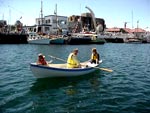
click images to enlarge |
A visit to my local timber merchant
turned up a large pack of 35x12 mm treated pined strips, 3.0 metres
in length, which are more usually stapled into lattice frames.
Seemed like just what we needed, so after some friendly price
negotiations the whole lot (enough for a few boats) found a new
home in the workshop.
We decided, tongue-in-cheek, that
“Huonville Pine” would be an apt name for the building
material, as we bought it in Huonville, which is the largest town
in the region of southern Tasmania where the illustrious Huon
Pine grows. We thought it would be quite a contrast in quality
to one of the best boat-building timbers in the world.
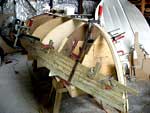 beginning to glue strips
beginning to glue strips
|
The Peapod’s dimensions were
gleaned from the magazine & the imperial mumbo-jumbo was converted
into metric measurements. Bob then lofted the half-breadths, from
which we took the moulds.
The stems were laminated from Celery
Top pine; the elliptical bottom section cut from 12mm ply.
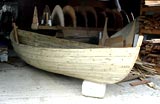 off the moulds
off the moulds |
The moulds were placed upside down,
& the strips went on from the gunwales up. We used Purbond
(a gap-filling polyeurethane adhesive compatible with epoxy resins)
along the horizontal joins, temporarily screwing the strips to
the moulds as we went. When we (invariably) snapped a strip, we
would butt join it with clamps to maintain the correct twist,
then move to the other side of the boat until a similar event
occurred.
The process became very difficult
as we approached the waterline, with twists & curves in the
strips causing frequent breaks. Solution: Rip the strips in half.
Then the whole process continued simply once again. Another three
laminates of Celery Top were laid over the strip ends as an outer
stem.
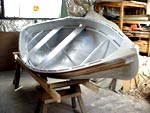 first coat of paint
first coat of paint
|
Many hours were spent sanding the
hull, fairing it with epoxy, sanding it back with a torture board,
& finally glassing it with 6mm cloth, doubled under the bottom.
The inside of the hull was given similar treatment, before breasthooks,
blocked-out inwales, gunwales, rubbing strakes, stern sheets &
thwarts were fitted. As expected, it turned out to be a very stiff
boat, with no need for ribs, floor timbers or knees off the thwarts.
As the boat was built primarily
for rowing, the centrecase was omitted. A Tasmanian oak keel about
50mm deep was added to help with directional stability.
The boat was sprayed twice with
two-part epoxy primer & finished with tow coats of paving
paint to give it a very hard-wearing finish.
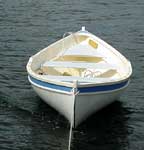 towing O'pinion
towing O'pinion |
We launched the boat in the Huon
River on a beautiful summer’s day in late January, naming
it “O’pinion”. It’s too complicated to
explain the derivation of the name, suffice to say that there
were occasional differences of opinion during its construction,
and it glides through the water like a bird on the wing. Everyone
found the 2.1 metre (7’) oars easy to use, but the later
addition of a pair of 2.4 m (8’) oars certainly made it
a very powerful boat.
We’ve had it out in some
testing conditions (20 knots & one metre-high swells); loaded
it with four adults & rowed through the surf off the beach;
my 12-year-old son Daniel spent hours rowing it around the Hobart
docks at the recent Australian Wooden Boat Festival; and I’ve
managed to put it to its intended use as a recreational “get
fit” machine. It’s a real pleasure to row - an hour
(& the scenery ) pass by very easily. The two rowing positions
offered by the offset thwart positions allow for a perfectly balanced
boat depending on load. She also runs before the wind easily when
standing in the stern with an oar hung aft as a sweep.
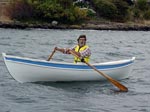 Bob in action
Bob in action |
O’pinion gathers admirers
where-ever we launch her, and Bob & I are very pleased with
our efforts. As for the traditionalists & knockers who comment
skeptically about her construction, we reckon she’ll be
around long after the 25-year treated pine warranty runs out !
And we merely repeat our motto : “We’re not constrained
by convention ! “.
(A word of caution to users
of CCA treated timbers. CCA stands for “copper/chrome/arsenic”.
Always wear a suitable face mask when sanding or sweeping up dust.
Off-cuts should not be burned.)
Greg Pullen
|

